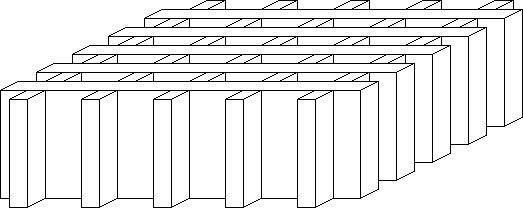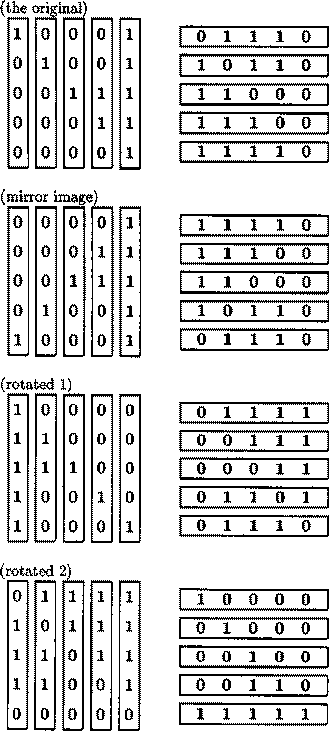| Lattice Practices |
Once upon a time, there was a king who loved beautiful costumes very much. The king had a
special cocoon bed to make excellent cloth of silk. The cocoon bed had 16 small square rooms,
forming a 4![]() 4 lattice, for 16 silkworms. The cocoon bed can be depicted as follows:
4 lattice, for 16 silkworms. The cocoon bed can be depicted as follows:

The cocoon bed can be divided into 10 rectangular boards, each of which has 5 slits:

Note that, except for the slit depth, there is no difference between the left side and the right side of the board (or, between the front and the back); thus, we cannot distinguish a symmetric board from its rotated image as is shown in the following:

Slits have two kinds of depth, either shallow or deep. The cocoon bed should be constructed by fitting five of the boards vertically and the others horizontally, matching a shallow slit with a deep slit.
Your job is to write a program that calculates the number of possible configurations to make the
lattice. You may assume that there is no pair of identical boards. Notice that we are interested
in the number of essentially different configurations and therefore you should not count mirror
image configurations and rotated configurations separately as different configurations.
The following is an example of mirror image and rotated configurations, showing vertical and
horizontal boards seperately, where shallow and deep slits are denoted by `1' and `0' respectively.

Notice that a rotation may exchange positions of a vertical board and a horizontal board.
xxxxx xxxxx xxxxx xxxxx xxxxx xxxxx xxxxx xxxxx xxxxx xxxxx
Each x is either `0' or `1'. `0' means a deep slit, and `1' a shallow slit. A block of five slit descriptions corresponds to a board. There are 10 blocks of slit descriptions in a line. Two adjacent blocks are separated by a space.
For example, the first data set in the Sample Input means the set of the following 10 boards:

The end of the input is indicated by a line consisting solely of three characters ``END''.
10000 01000 00100 11000 01100 11111 01110 11100 10110 11110 10101 01000 00000 11001 01100 11101 01110 11100 10110 11010 END
40 6